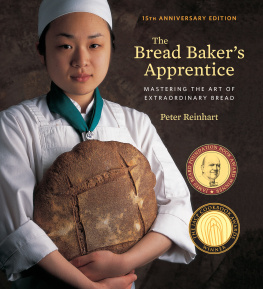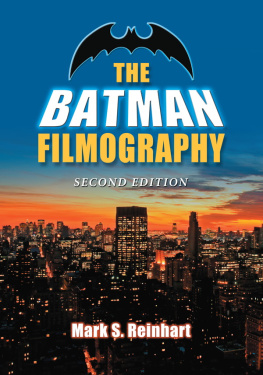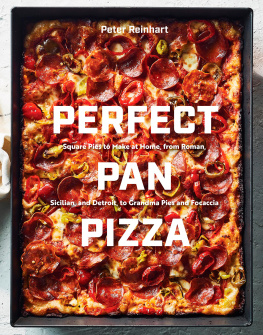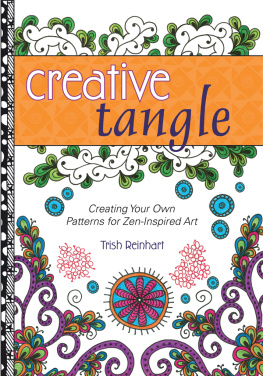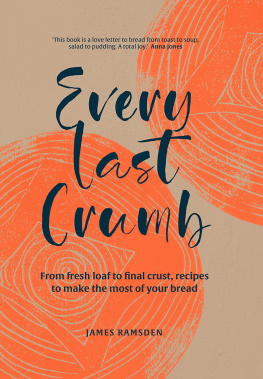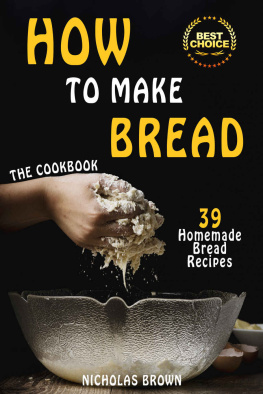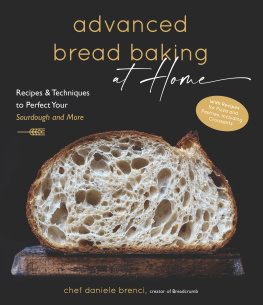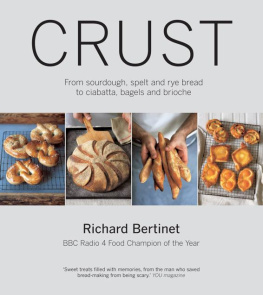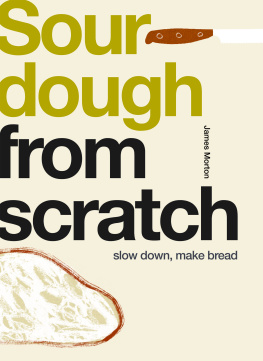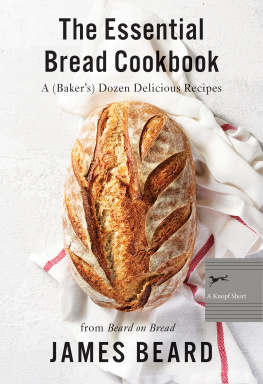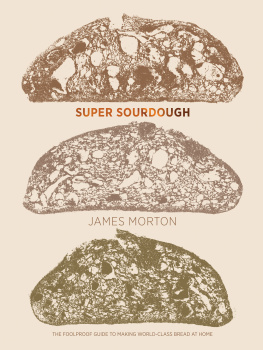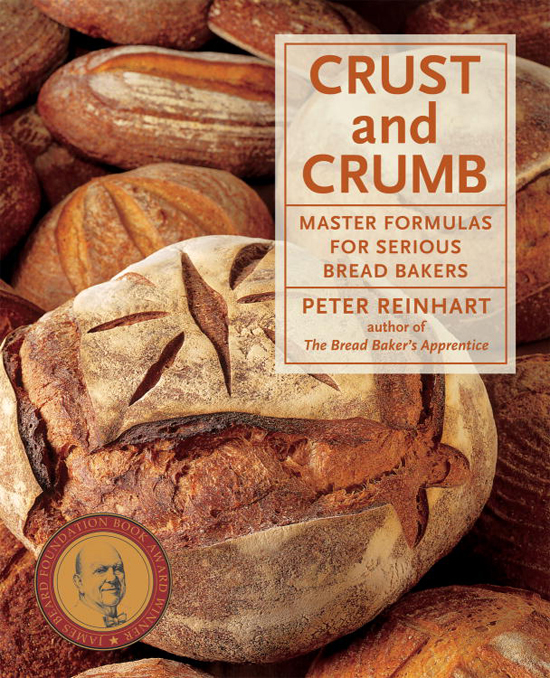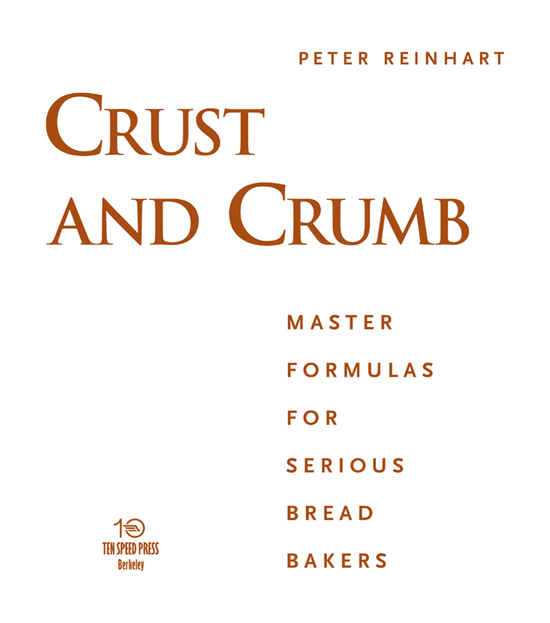Copyright 1998, 2006 by Peter Reinhart
Cover photograph 1998, 2006 by Teri Sandison
All rights reserved. Published in the United States by Ten Speed Press, an imprint of the Crown Publishing Group, a division of Random House, Inc., New York.
www.crownpublishing.com
www.tenspeed.com
Ten Speed Press and the Ten Speed Press colophon are registered trademarks of Random House, Inc.
Library of Congress Cataloging-in-Publication Data
Reinhart, Peter.
Crust & Crumb: master formulas for serious bread bakers / by
Peter Reinhart.
p. cm.
Includes bibliographical references and index.
1. Bread. I. Title.
TX769.R415 1998 98-18538
641.815dc21
eISBN: 978-1-60774-132-9
Cover design by Nancy Austin
Illustrations by Ellen Sasaki
v3.1
CONTENTS
4. THE QUALITY OF GRAIN:
THE WHOLE-WHEAT RENAISSANCE
5. THE ROMANCE OF WOOD-FIRED BRICK OVENS,
AND A FEW ADVANCED TECHNIQUES
6. ENRICHED DOUGH: NOT WHAT YOU
PUT ON BUT WHAT YOU PUT IN
7. A TORTILLA BY ANY OTHER NAME:
FLATBREADS AROUND THE WORLD
8. THE BANANA BREAD REVOLUTION:
BREADS FROM OTHER LEAVENS
PREFACE
While I was writing my first two books, the editors continually reminded me to view my books first and foremost as cookbooks and only secondarily as vehicles for philosophizing. Thankfully, I was able to achieve a balance that was acceptable to me, the publisher, and the many readers who sent me favorable comments. So I thought it pleasantly ironic when one of the editors I worked with on this book said, Dont forget the philosophy. We dont want this to be just a recipe book. With that in mind, I have delved into my experience for more insights into the relationship, both metaphorical and physical, between bread and life.
Life goes on from moment to moment, experience to experience, and never seems to stop offering lessons for growth. What many people lack, though, is a way to tie these experiences into a meaningful whole, a context in which to experience the connectedness of all creation. Many of these potential life lessons slip past us because we do not have an adequate gathering net. For me, bread is one of those nets.
There is a form of writing called object poetry. The idea, when writing object poetry, is to describe something not with similes and metaphors, but in very concrete terms. Like peeling layers of an onion (a simile that, ironically, would not meet the criteria), the more deeply you explore the actuality of an object the more it seems to transcend itself and become universal, archetypal, and ideal. This book was written to capture that spirit. Rather than try to build metaphorical bridges between the real and ideal, as I did in my previous books, I have focused on the actuality of bread. I want this book to be an object poem that takes you deeper into the subject as it broadens your experience.
I was quoted once in a food magazine discussing the mystical qualities of bread making and how I thought bread bakers were spiritual even if they might not view themselves as particularly religious. One baker wrote an angry response saying she did not make bread for a religious experience and did not think that making bread was particularly spiritual. She was not looking for deeper meaning from bread; she wanted to make something that tasted good and looked beautiful. Period.
She would probably be surprised to find me agreeing with her. I do, however, also happen to think that dedicating oneself to making things that taste good and look beautiful is a very spiritual act indeed; it sounds to me as though she had come close to tapping into one of the mysteries of the meaning of life, and I deeply respect her achievement, by whatever name she calls it.
The word religion derives from a Latin root word, religio, meaning to be connected to. I find that many bread bakers have an intuitive sense of connectedness, whether or not they consider themselves spiritual or religious. The quest for beauty and goodness, in any endeavor, is the basis for many metaphorical and mystical, as well as practical, excursions.
In this book, I will explain much about building, rather than making, a loaf of bread, because I have discovered that the best bread is built in stages and thus has many levels. We will explore the value of slow-rise fermentation techniques, not because slow rise is a metaphor but because it is an effective method. I will not be rhapsodizing about beauty and truth, much as I might like to. Instead, I will be teaching you how to make a loaf of bread that is rhapsodically beautiful and exceptionally delicious.
Along the way I will share some of the things I have learned about bread during my culinary journey. The life part, for you and for me, will just have to happen as part of the process, nourished by the hoped-for objects of goodness and beauty that we will make together.
Peter Reinhart
Santa Rosa, California
ACKNOWLEDGMENTS
As always, my chief collaborator is my wife, Susan, who supported me through the daily grind and served as my pre-editor on all levels. Her palate and patience are big parts of our success.
My students at the California Culinary Academy (CCA), too numerous to mention by name, were also among the first to test the formulas developed for this book, pointing out where instructions were unclear or measurements slightly off and oftentimes making improvements. They were beneficiaries of my knowledge, guinea pigs for my experiments, and always joyful co-conspirators in furthering the bread revolution. I must also thank Keith Keough, president of the CCA; Greg Tompkins, director of faculty (now at the National Baking Center in Minneapolis); and Robert Parks, my department head in the Baking and Pastry Program for their continual support and encouragement. I have been privileged to work with outstanding colleagues at the CCA and thank them all for accepting me as their peer. A special thanks to Chef Tony Marano for his help with the instructional graphics.
This book was given its original life by Meesha Halm, who recruited me for a publisher other than Ten Speed Press. Fortunately for all of us, after a publishing adventure worthy of Tolkien, we were then encouraged to place my manuscript into the nurturing hands of Ten Speed, under the direction of publisher Kirsty Melville; my editor, Chelsea Vaughn; and the superb Ten Speed team, especially art director Nancy Austin. I owe all of them my gratitude for their enthusiastic belief in the importance of this book and their role in shaping it. I also must give a hearty thank-you to Kathy Martin, who did a superb job of editing the original manuscript into shape for submission, and to Susan Derecskey for her fine-tuning and editorial expertise.
I was thrilled beyond belief when Ten Speed offered to bring in Teri Sandison as the photographer. I have long been a fan of her work, especially in her collaborations with her husband, Hugh Carpenter, on their many books. I could not have asked for a better Christmas gift than to find her pictures in my stocking. A special thank you to Kathleen Kennedy for her help with the food styling. And thanks also to R.S. Basso in St. Helena, California, for loaning us props and accessories for the photos; and to Food for Thought Bakery in Santa Rosa, California, for allowing us to use their beautiful loaves for our cover shot.
As always, thanks to my superb agent, Pam Bernstein, and her wonderful assistant Donna Downing, for protecting me and freeing me to focus on my writing.


